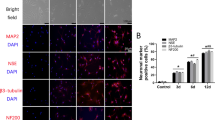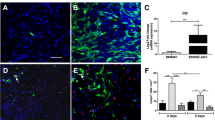Summary
Post-translational modifications of cellular proteins with ubiquitin or ubiquitin-like proteins regulate many cellular processes, such as cell proliferation, differentiation, apoptosis, signal transduction, intercellular immune recognition, inflammatory response, stress response, and DNA repair. Nice4/UBAP2L is an important member in the family of ubiquitin-like proteins, and its biological function remains unknown. This study aimed to investigate the effect of UBAP2L on spinal cord injury (SCI). At first, rat bone marrow mesenchymal stem cells (BMSCs) were infected with adeno-associated virus to induce over-expression of Nice4. Subsequently, the infected BMSCs were transplanted into rats suffering from semi-sectioned SCI. The results showed that the over-expression of Nice4 significantly promoted the proliferation and differentiation of BMSCs. In addition, the transplantation of infected BMSCs into the injured area of SCI rats improved the function repair of SCI. Importantly, the immunohistochemical and hematoxylin-eosin staining and RT-PCR results showed that the number of neuronal cells, oligodendrocytes, and astrocytes was significantly increased in the injured area, along with significantly upregulated expression of cyclin D1 and p38 mitogen-activated protein kinase (MAPK). Meanwhile, the expression of caspase 3 protein was significantly down-regulated. In conclusion, the over-expression of Nice4 gene can promote the functional recovery in SCI rats by promoting cell proliferation and inhibiting apoptosis. The results of this study indicate an alternative option for the clinical treatment of SCI.
Similar content being viewed by others
References
Assinck P, Duncan GJ, Hilton BJ, et al. Cell transplantation therapy for spinal cord injury. Nat Neurosci, 2017,20(5):637–647
Goolsby J, Marty MC, Heletz D, et al. Hematopoietic progenitors express neural genes. Proc Natl Acad Sci USA, 2003,100(25):14926–14931
Chopp M, Zhang XH, Li Y, et al. Spinal cord injury in rat: treatment with bone marrow stromal cell transplantation. Neuroreport, 2000,11(13):3001–3005
Mezey E, Chandross KJ. Bone marrow: a possible alternative source of cells in the adult nervous system. Eur J Pharmacol, 2000, 405(1-3):297–302
Sagara J, Makino N. Glutathione induces neuronal differentiation in rat bone marrow stromal cells. Neurochem Res, 2008,33(1):16–21
Gazdic M, Volarevic V, Arsenijevic A, et al. Stem Cells and Labeling for Spinal Cord Injury. Int J Mol Sci, 2016, 18(1). pii: E6
Gage FH, Temple S. Neural stem cells: generating and regenerating the brain. Neuron, 2013,80(3):588–601
Zhao Y, Zuo Y, Jiang J, et al. Neural stem cell transplantation combined with erythropoietin for the treatment of spinal cord injury in rats. Exp Ther Med, 2016,12(4):2688–2694
Ankeny DP, McTigue DM, Jakeman LB. Bone marrow transplants provide tissue protection and directional guidance for axons after contusive spinal cord injury in rats. Exp Neurol, 2004,190(1):17–31
Jeong SW, Chu K, Jung KH, et al. Human neural stem cell transplantation promotes functional recovery in rats with experimental intracerebral hemorrhage. Stroke, 2003,34(9):2258–2263
Stenudd M, Sabelstrom H, Frisen J. Role of endogenous neural stem cells in spinal cord injury and repair. JAMA Neurol, 2015,72(2):235–237
Mackay-Sim A, St John JA. Olfactory ensheathing cells from the nose: clinical application in human spinal cord injuries. Exp Neurol, 2011,229(1):174–180
Saberi H, Firouzi M, Habibi Z, et al. Safety of intramedullary Schwann cell transplantation for postrehabilitation spinal cord injuries: 2-year follow-up of 33 cases. J Neurosurg Spine, 2011,15(5):515–525
Wilde IB, Brack M, Winget JM, et al. Proteomic characterization of aggregating proteins after the inhibition of the ubiquitin proteasome system. J Proteome Res, 2011,10(3):1062–1072
Zurita M, Vaquero J. Functional recovery in chronic paraplegia after bone marrow stromal cells transplantation. Neuroreport, 2004,15(7):1105–1108
Sawyer JR. The prognostic significance of cytogenetics and molecular profiling in multiple myeloma. Cancer Genet, 2011,204(1): 3–12
Naz RK, Dhandapani L. Identification of human sperm proteins that interact with human zona pellucida3 (ZP3) using yeast two-hybrid system. J Reprod Immunol, 2010,84(1): 24–31
Chai R, Yu X, Tu S, et al. Depletion of UBA protein 2-like protein inhibits growth and induces apoptosis of human colorectal carcinoma cells. Tumour Biol, 2016,37(10):13225–13235
Madura K. The ubiquitin-associated (UBA) domain: on the path from prudence to prurience. Cell cycle, 2002,1(4):235–44
Mani A, Gelmann EP. The ubiquitin-proteasome pathway and its role in cancer. J Clin Oncol, 2005,23(21):4776–4789
Ono K, Han J. The p38 signal transduction pathway: activation and function. Cell Signal, 2000,12(1):1–13
Rodriguez-Gonzalez A, Cyrus K, Salcius M, et al. Targeting steroid hormone receptors for ubiquitination and degradation in breast and prostate cancer. Oncogene, 2008,27(57): 7201–11
Li D, Huang Y. Knockdown of ubiquitin associated protein 2-like inhibits the growth and migration of prostate cancer cells. Oncol Rep, 2014,32(4):1578–1584
Bordeleau ME, Aucagne R, Chagraoui J, et al. UBAP2L is a novel BMI1-interacting protein essential for hematopoietic stem cell activity. Blood, 2014,124(15): 2362–2369
Silva NA, Sousa N, Reis RL, et al. From basics to clinical: a comprehensive review on spinal cord injury. Prog Neurobiol, 2014,114:25–57
Itosaka H, Kuroda S, Shichinohe H, et al. Fibrin matrix provides a suitable scaffold for bone marrow stromal cells transplanted into injured spinal cord: A novel material for CNS tissue engineering. Neuropathology, 2009,29(3):248–257
Livak KJ, Schmittgen TD. Analysis of relative gene expression data using real-time quantitative Pcr and the 2(-Delta Delta C(T)) method. Methods, 2001,25(4):402–408
Tan W, Deans AJ. A defined role for multiple Fanconi anemia gene products in DNA-damage-associated ubiquitination. Exp Hematol, 2017,50:27–32
Zhang J, Liu X. Human neural stem cells with GDNF site-specific integration at AAVS1 by using AAV vectors retained their stemness. Neurochem Res, 2018,43(4):930–937
Christie PJ, Gordon JE. The agrobacterium Ti plasmids. Microbiol Spectr, 2014,2(6):1011–1128
Bordeleau ME, Aucagne R, Chagraoui J, et al. UBAP2L is a novel BMI1-interacting protein essential for hematopoietic stem cell activity. Blood, 2014,124(15): 2362–2369
Li D, Huang Y. Knockdown of ubiquitin associated protein 2-like inhibits the growth and migration of prostate cancer cells. Oncol Rep, 2014,32(4):1578–1584
Filipcik P, Curry JR, Mace PD. When worlds collidemechanisms at the interface between phosphorylation and ubiquitination. J Mol Biol, 2017,429(8):1097–1113
Nagel AK, Schilling M, Comte-Walters S, et al. Identification of O-linked N-acetylglucosamine (O-GlcNAc)-modified osteoblast proteins by electron transfer dissociation tandem mass spectrometry reveals proteins critical for bone formation. Mol Cellular Proteomics, 2013,12(4):945–955
Mukherjee R, Das A, Chakrabarti S, et al. Calcium dependent regulation of protein ubiquitination-interplay between E3 ligases and calcium binding proteins. Biochim Biophys Acta, 2017,1864(7):1227–1235
Si F, Sun J, Wang C. MicroRNA-138 suppresses cell proliferation in laryngeal squamous cell carcinoma via inhibiting EZH2 and PI3K/AKT signaling. Exp Ther Med, 2017,14(3):1967–1974
Shepherd DJ, Tsai SY, Cappucci SP, et al. The subventricular zone response to stroke is not a therapeutic target of anti-Nogo-A immunotherapy. J Neuropath Exp Neur, 2017,76(8):683–696
Luo J, Hu YL, Wang H. Ursolic acid inhibits breast cancer growth by inhibiting proliferation, inducing autophagy and apoptosis, and suppressing inflammatory responses via the PI3K/AKT and NF-kappaB signaling pathways in vitro. Exp Ther Med, 2017,14(4):3623–3631
Dai G, Zhang Z, Zhou M, et al. The role of mitogenactivated protein kinase (MAPK) pathway in the action mechanism of PYM-induced KB cells apoptosis. Zhonghua Kou Qiang Yi Xue Za Zhi (Chinese), 2002,37(2):97–98
Author information
Authors and Affiliations
Corresponding author
Additional information
This study was supported by the National Natural Science Foundation of China (No. 81271347).
Rights and permissions
About this article
Cite this article
Lin, Gl., Wang, H., Dai, J. et al. Upregulation of UBAP2L in Bone Marrow Mesenchymal Stem Cells Promotes Functional Recovery in Rats with Spinal Cord Injury. CURR MED SCI 38, 1081–1089 (2018). https://doi.org/10.1007/s11596-018-1987-x
Received:
Revised:
Published:
Issue Date:
DOI: https://doi.org/10.1007/s11596-018-1987-x




